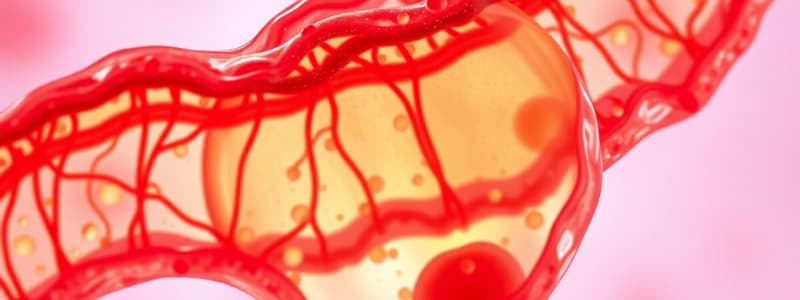Podcast
Questions and Answers
What are the three fundamental structures of a cell?
What are the three fundamental structures of a cell?
- Cell wall, cytoplasm, nucleus
- Cell membrane, organelles, endoplasmic reticulum
- Cell membrane, cytoplasm, nucleus (correct)
- Cytoplasm, organelles, vacuole
Which organelle is responsible for energy production in animal cells?
Which organelle is responsible for energy production in animal cells?
- Golgi apparatus
- Mitochondria (correct)
- Ribosome
- Lysosome
What percentage of the dry weight of the cell membrane is contributed by lipids?
What percentage of the dry weight of the cell membrane is contributed by lipids?
- 45% (correct)
- 30%
- 50%
- 60%
Which model describes the structure of the cell membrane?
Which model describes the structure of the cell membrane?
What is the primary function of the cell membrane?
What is the primary function of the cell membrane?
What are the filamentous structures in the cytoplasm known as?
What are the filamentous structures in the cytoplasm known as?
Which of the following contributes most significantly to the structure of the cell membrane?
Which of the following contributes most significantly to the structure of the cell membrane?
What characteristic of the fluid-mosaic model allows the membrane to maintain flexibility?
What characteristic of the fluid-mosaic model allows the membrane to maintain flexibility?
What is the term used for the rapid diffusion within the plane of the membrane for phospholipids?
What is the term used for the rapid diffusion within the plane of the membrane for phospholipids?
What primarily affects the fluidity of a cell membrane?
What primarily affects the fluidity of a cell membrane?
What happens to the hydrophobic chains of fatty acids when temperature increases?
What happens to the hydrophobic chains of fatty acids when temperature increases?
Which of the following lipids is NOT a major component of cell membranes?
Which of the following lipids is NOT a major component of cell membranes?
What is the relationship between the degree of unsaturation of fatty acids and membrane fluidity?
What is the relationship between the degree of unsaturation of fatty acids and membrane fluidity?
What kind of molecules are described as amphipathic?
What kind of molecules are described as amphipathic?
What is the main role of cholesterol in the cell membrane?
What is the main role of cholesterol in the cell membrane?
Which of the following phospholipids is NOT found in the cell membrane?
Which of the following phospholipids is NOT found in the cell membrane?
Flashcards
Cell Membrane Function
Cell Membrane Function
Controls what enters and exits the cell and helps cells interact.
Fluid Mosaic Model
Fluid Mosaic Model
Describes the structure of cell membranes as a double layer of lipids with proteins embedded.
Cell Membrane Composition
Cell Membrane Composition
Primarily made of phospholipids, proteins, and carbohydrates.
Cell Components
Cell Components
Signup and view all the flashcards
Cytoplasm
Cytoplasm
Signup and view all the flashcards
Cytoplasm Organelles
Cytoplasm Organelles
Signup and view all the flashcards
Cell membrane structure
Cell membrane structure
Signup and view all the flashcards
Cell - Functional Unit
Cell - Functional Unit
Signup and view all the flashcards
Translational Diffusion
Translational Diffusion
Signup and view all the flashcards
Lipid Bilayer Structure
Lipid Bilayer Structure
Signup and view all the flashcards
Transition Temperature (Tm)
Transition Temperature (Tm)
Signup and view all the flashcards
Membrane Fluidity
Membrane Fluidity
Signup and view all the flashcards
Cholesterol in Membranes
Cholesterol in Membranes
Signup and view all the flashcards
Amphipathic Molecules
Amphipathic Molecules
Signup and view all the flashcards
Factors Affecting Membrane Fluidity
Factors Affecting Membrane Fluidity
Signup and view all the flashcards
Phospholipids
Phospholipids
Signup and view all the flashcards
Study Notes
Cell Structure and Function
- Cells are the fundamental units of tissues, with three key components: cell membrane, cytoplasm, and nucleus.
- The cell membrane (plasma membrane) surrounds the cytoplasm, a fluid containing organelles.
- Cytoplasm holds various organelles like mitochondria, ribosomes, peroxisomes, lysosomes, centrioles, endoplasmic reticulum, and Golgi apparatus, as well as cytoskeletal filaments (microfilaments, intermediate filaments, microtubules).
- The nucleus is centrally located.
- Other proteins like actin and myosin provide strength, mobility, and cell-to-cell adhesion.
Cell Membrane Detail
- The cell membrane is a protective barrier, exchanging materials, facilitating cell communication, and anchoring cells.
- Structurally, it's a phospholipid bilayer (7-10 nm thick) with embedded and attached proteins.
- Lipids (45%), proteins (50%), and carbohydrates (5%) make up the major membrane components.
Fluid Mosaic Model
- Widely accepted model for cell membrane structure.
- A double layer of phospholipids with proteins embedded or attached, which are loosely associated and mobile.
- Phospholipids and proteins move within the membrane, maintaining fluidity without structural damage. ("translational diffusion").
- Membrane fluidity is determined by lipid composition—specifically, the ratio of saturated vs. unsaturated fatty acids and the presence of cholesterol.
Lipid Bilayer Components
- Phospholipids (phosphatidylcholine, sphingomyelin, phosphatidylserine, phosphatidylethanolamine) are major components
- Glycolipids are primarily on the outer layer.
- Cholesterol reinforces the permeability barrier, influencing membrane fluidity.
- Lipids are amphipathic: a hydrophilic (water-loving) head and hydrophobic (water-fearing) tails. The tails cluster inward, while the heads face the aqueous environment inside and outside the cell.
- Similar bilayer structures exist in other biological systems like bile salts.
Membrane Fluidity Factors
- Temperature affects membrane fluidity. Higher temperatures lead to greater fluidity.
- Saturated fatty acids in long chains result in higher transition temperatures (Tm), reducing fluidity at lower temperatures.
- Unsaturated fatty acids lower Tm, increasing fluidity.
- Cholesterol influences fluidity by interacting with phospholipids. The cholesterol-phospholipid ratio influences membrane fluidity.
Studying That Suits You
Use AI to generate personalized quizzes and flashcards to suit your learning preferences.




